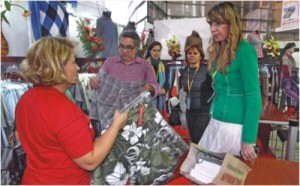


December 13, 2011
Garment buyers are upbeat on Bangladesh
International buyers look to long-term apparel business ties in Bangladesh as the country has the potential to supply quality apparel items. Garment exports from Bangladesh may not be deeply hurt by a debt crisis in the European Union, as the country has strong competitiveness, buyers said.
As other competing countries like China, Vietnam, India and Pakistan are facing higher costs of production, Bangladesh is becoming more popular with the buyers for affordable prices of garment items.
The Daily Star caught up with some buyers at the BATEXPO 2011 that ended yesterday at Bangabandhu International Conference Centre.
“The export of garments from Bangladesh will remain unhurt for the next 15-20 years as the country has potential,” said Nihal Mudalige, a manager of Mondial Orient Ltd.
Mondial is a sister concern of German-based C&A Company, which has more than 1,500 retail outlets across Europe. “Mondial purchases garments worth $700 million a year from Bangladesh,” he said.
This year, the company has also increased its purchases to 20 percent, he said adding every year his company increases the volume of the orders from Bangladesh by at least 10 percent.
He mainly purchases jeans, shorts, children's wear, woven and knitwear products.
He said his company buys garment items from 125 garment factories in Bangladesh.
“We are here mainly for the lower prices of garment items as the prices of apparel items in other countries have already gone up following the higher costs of production.”
He said China is suffering from a shortage of workers and higher costs of production.
Moreover, the current generation in China is no longer interested in the garment businesses.
The new generation is much more interested in doing jobs sitting in air-conditioned rooms, he said.
Rajan Kohli, country manager of US based Roochi Traders Inc having operations in Bangladesh, said exploiting the country's potential in RMG mainly depends on the mobility of goods from Dhaka to the ports for shipment.
Moreover, export growth also depends on an adequate supply of gas and power to the industrial units, he said.
The company's brand name is 'Cotton Heritage' for exclusive buyers in the US, he said. He said he purchases nearly five lakh garment items, mainly T-shirts, a month.
“The country's exports will increase with improvements in the recession in the US,” he said.
Chuck Koussan, of United Line Trading Ltd, now sources garments products from China.
He said they are planning to set up a buying house in Bangladesh.
"Then we will consider whether we will set up any manufacturing unit in Bangladesh or not, as we are seriously thinking about shifting our factory from China. Bangladesh can be a good source for us."
"We met a number of people here and discussed our business potential. We have found that Bangladesh is more competitive than China due to cheaper labour, utilities and land."
The American said production costs in China are increasing in China due to higher labour costs. "We will definitely set up a manufacturing plant in Bangladesh if we find a difference in production costs.”
Koussan's company sells products in the Middle East, the US, EU and North Africa. Its annual turnover averages between $30 and $50 million, with annual growth rate at about 15 percent.
Svend Olling, Danish ambassador to Bangladesh, said the country's export growth, which is centered round the garments industry, is the primary driver of Bangladesh's economy. “It will go a long way in future.”
At a seminar on the sidelines of the three-day fair yesterday, he said: “We only look at employment and the earnings part of the sector. It is also a platform for women's empowerment in Bangladesh. That is only one of many achievements of the garments industry.”
“Secondly, service infrastructure is being built in Bangladesh. Thirdly and more importantly, the industry is helping change the image of Bangladesh at international arenas."
Olling said many businessmen, who never considered Bangladesh a sourcing country, are now thinking about it after China and India.
"The business community is communicating with the international community; Bangladesh is open for business, where they can invest for the benefit of Bangladesh and investors."
"When any business delegation comes from Denmark, I want to know their perception about Bangladesh. They talk about floods and a political crisis. But they say they had different ideas about Bangladesh."
Olling said the country's entrepreneurs and workers are bringing about the change. "They say there is a people factor. They say the people are hard-working, resilient, innovative and patient. That is the most selling point of Bangladesh. In the garments sector, they are professional and understand the needs of the buyers. This is the real potential for the future of Bangladesh."
Organisers say they have received expected responses from the foreign buyers. Already a number of new buyers from Bangladesh's traditional export destinations, such as America, Canada, and EU, and new markets such as the Middle East, China, Malaysia, Japan, Russia, Hong Kong and Argentina have enquired about factories and the business potential here.
They have also registered with the BGMEA Registration Desk on the fair premises, said an official of the country's top apparel exporters' association.
Bangladesh Garment Manufacturers and Exporters Association has organised the fair where local and foreign companies showcased their products and services in 146 stalls.

Copyright © 2020, The Bangladesh Garment Manufacturers and Exporters Association.
Version-2.0, Design & Developed by Systech Digital Limited.
Version-2.0, Design & Developed by Systech Digital Limited.
